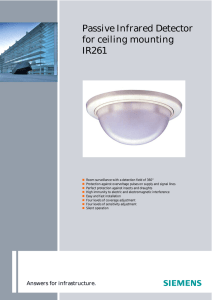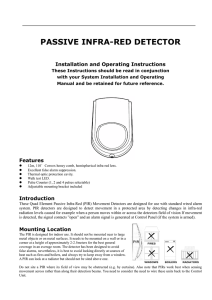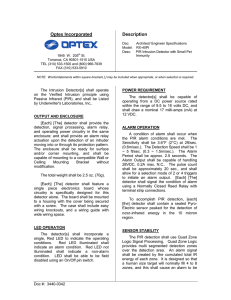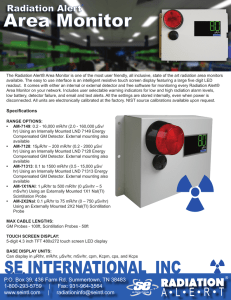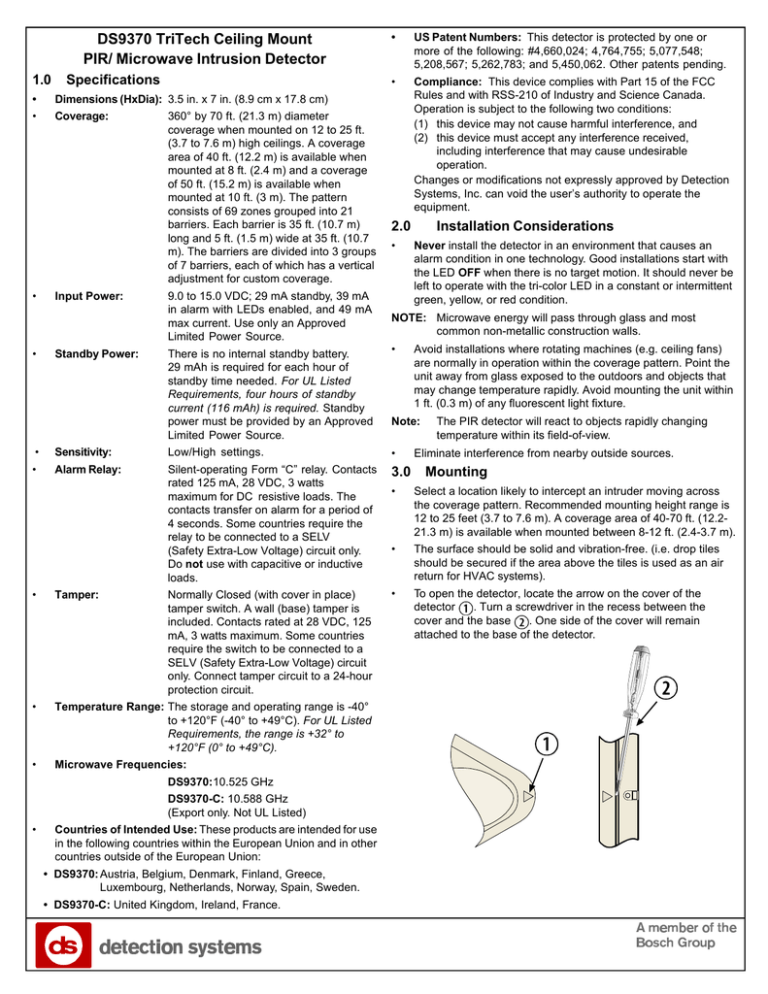
DS9370 TriTech Ceiling Mount
PIR/ Microwave Intrusion Detector
1.0
Specifications
•
Dimensions (HxDia): 3.5 in. x 7 in. (8.9 cm x 17.8 cm)
•
Coverage:
•
•
Input Power:
Standby Power:
360° by 70 ft. (21.3 m) diameter
coverage when mounted on 12 to 25 ft.
(3.7 to 7.6 m) high ceilings. A coverage
area of 40 ft. (12.2 m) is available when
mounted at 8 ft. (2.4 m) and a coverage
of 50 ft. (15.2 m) is available when
mounted at 10 ft. (3 m). The pattern
consists of 69 zones grouped into 21
barriers. Each barrier is 35 ft. (10.7 m)
long and 5 ft. (1.5 m) wide at 35 ft. (10.7
m). The barriers are divided into 3 groups
of 7 barriers, each of which has a vertical
adjustment for custom coverage.
9.0 to 15.0 VDC; 29 mA standby, 39 mA
in alarm with LEDs enabled, and 49 mA
max current. Use only an Approved
Limited Power Source.
•
US Patent Numbers: This detector is protected by one or
more of the following: #4,660,024; 4,764,755; 5,077,548;
5,208,567; 5,262,783; and 5,450,062. Other patents pending.
•
Compliance: This device complies with Part 15 of the FCC
Rules and with RSS-210 of Industry and Science Canada.
Operation is subject to the following two conditions:
(1) this device may not cause harmful interference, and
(2) this device must accept any interference received,
including interference that may cause undesirable
operation.
Changes or modifications not expressly approved by Detection
Systems, Inc. can void the user’s authority to operate the
equipment.
2.0
•
•
Sensitivity:
Low/High settings.
•
•
Alarm Relay:
Silent-operating Form “C” relay. Contacts
rated 125 mA, 28 VDC, 3 watts
maximum for DC resistive loads. The
contacts transfer on alarm for a period of
4 seconds. Some countries require the
relay to be connected to a SELV
(Safety Extra-Low Voltage) circuit only.
Do not use with capacitive or inductive
loads.
3.0
Normally Closed (with cover in place)
tamper switch. A wall (base) tamper is
included. Contacts rated at 28 VDC, 125
mA, 3 watts maximum. Some countries
require the switch to be connected to a
SELV (Safety Extra-Low Voltage) circuit
only. Connect tamper circuit to a 24-hour
protection circuit.
•
Temperature Range: The storage and operating range is -40°
to +120°F (-40° to +49°C). For UL Listed
Requirements, the range is +32° to
+120°F (0° to +49°C).
•
Microwave Frequencies:
DS9370:10.525 GHz
DS9370-C: 10.588 GHz
(Export only. Not UL Listed)
•
Countries of Intended Use: These products are intended for use
in the following countries within the European Union and in other
countries outside of the European Union:
• DS9370: Austria, Belgium, Denmark, Finland, Greece,
Luxembourg, Netherlands, Norway, Spain, Sweden.
• DS9370-C: United Kingdom, Ireland, France.
Avoid installations where rotating machines (e.g. ceiling fans)
are normally in operation within the coverage pattern. Point the
unit away from glass exposed to the outdoors and objects that
may change temperature rapidly. Avoid mounting the unit within
1 ft. (0.3 m) of any fluorescent light fixture.
Note:
•
Tamper:
Never install the detector in an environment that causes an
alarm condition in one technology. Good installations start with
the LED OFF when there is no target motion. It should never be
left to operate with the tri-color LED in a constant or intermittent
green, yellow, or red condition.
NOTE: Microwave energy will pass through glass and most
common non-metallic construction walls.
There is no internal standby battery.
29 mAh is required for each hour of
standby time needed. For UL Listed
Requirements, four hours of standby
current (116 mAh) is required. Standby
power must be provided by an Approved
Limited Power Source.
•
Installation Considerations
The PIR detector will react to objects rapidly changing
temperature within its field-of-view.
Eliminate interference from nearby outside sources.
Mounting
•
Select a location likely to intercept an intruder moving across
the coverage pattern. Recommended mounting height range is
12 to 25 feet (3.7 to 7.6 m). A coverage area of 40-70 ft. (12.221.3 m) is available when mounted between 8-12 ft. (2.4-3.7 m).
•
The surface should be solid and vibration-free. (i.e. drop tiles
should be secured if the area above the tiles is used as an air
return for HVAC systems).
•
To open the detector, locate the arrow on the cover of the
detector
. Turn a screwdriver in the recess between the
cover and the base
. One side of the cover will remain
attached to the base of the detector.
•
If necessary, you may remove the base from the cover by
pressing the two cover release tabs
inward while lifting the
base away from the cover.
5.0
Wiring
CAUTION
Note:
Only apply power after all connections have been
made and inspected. Do not coil excess wiring
inside detector.
Input power must use only an Approved Limited Power
Source. Some countries require that the Alarm and Tamper
Contacts be connected to a SELV (Safety Extra-Low
Voltage) circuit only.
POWER ALARM TAMPER
•
Route wiring as necessary to the rear of the base and through
the center hole.
Note:
•
Be sure all wiring is de-energized before routing.
Firmly mount the base. Depending on local regulations, the
base may be directly surface mounted using anchors, mollies,
or wing-nuts. It may also be mounted to standard 3.5 in.
octagonal electrical box. The detector may also be connected
directly to short lengths (short enough to avoid movement of the
detector) of ½ in. (1.27 cm) EMT.
Hint:
Mounting to removable ceiling tiles is not recommended
unless a sandwich is made of the base, ceiling tile, and a
back plate behind the tile.
-
+
-
+
NO
C
NC
T
T
M
•
Terminals 1 (-) & 2 (+): Power limits are 9 to 15 VDC. Use no
smaller than #22 AWG (0.8 mm) wire pair between the unit and
the power source.
•
Terminals 3 (NO), 4 (C), & 5 (NC): Alarm relay contacts rated
125 mA, 28 VDC maximum for DC resistive loads. Use
terminals 4 & 5 for Normally Closed circuits. Do not use with
capacitive or inductive loads.
•
Terminals 6 (T) & 7 (T): Normally Closed tamper contacts
rated at 28 VDC, 125 mA.
•
Terminal 8 (M): The memory mode requires a supply voltage
on Terminal 8 to be activated. See Section 9.1 for operation and
wiring information.
6.0
LED Operation
The detector uses a tri-color LED to indicate the various alarm and
supervision trouble conditions that may exist. See chart below.
LED
Steady red
Steady yellow
Steady green
Flashing red
Note:
Mounting Base
Wire entrance and/or EMT Mounting.
Mounting holes.
Tamper Post.
Wire entrance for surface mounting.
•
7.0
If ceiling tamper is desired, loosen the tamper post by cutting
the 3 tabs
and mount the post to the ceiling using a #8
screw .
Cause
Unit alarm
Microwave activation (walk test)
PIR activation (walk test)
Warmup period after power-up
During walk testing, the LED will light for the first
technology (microwave or PIR) and then light red to
indicate a detector alarm. The LED will not indicate
activation of the second technology by lighting its color.
Feature Selection
HIGH
ON
LOW
OFF
MAX
7.1
PIR Signal
Gain
PIR Sensitivity Selection Pins
For selection, place the plug across the appropriate pins.
DS9370 Installation Instructions
•
Low Sensitivity (LO): The recommended setting for most
installations. This setting tolerates environment extremes. The
detector is shipped in Low Sensitivity mode.
•
High Sensitivity (HI): Use in locations where adequate catch
performance is not achieved in the Low Sensitivity mode. This
setting tolerates only minor environmental changes.
© 2002 Detection Systems, Inc. All rights reserved.
Page 2
P/N 48781C
7.2
LED On/Off Pins
The ON position allows operation of the tri-color LED. If LED
indication is not desired after setup and walk tests are completed,
place in the OFF position.
7.3
Microwave Adjustment
Note:
It is important to wait 1 minute after removing/replacing the
cover so the microwave portion of the detector can settle,
and to wait at least 5 seconds between the following walk
testing procedures.
•
The tri-color LED should be OFF before walk testing.
•
Walk test across the pattern at the intended coverage’s
farthest end. Start walking from outside the intended protection
area and observe the tri-color LED. The edge of the microwave
pattern is determined by the first yellow microwave activation of
the LED (or the first red activation if the green PIR LED
activates first).
•
If adequate range can not be reached, increase the Microwave
Range Adjust slightly. Continue walk testing (waiting 1 minute
after removing/replacing the cover) and adjusting the range until
the farthest edge of desired coverage has been accurately
placed.
Do not adjust the microwave range higher than required.
•
•
Day Mode: The Day Mode disables the alarm memory and
allows the LED (if activated) to operate normally.
•
Memory: When the DS9370 is in the Night Mode the memory
is activated. This allows the detector to store an alarm for
display at a later time.
•
Night Mode: The Night Mode enables the alarm memory and
disables the LED operation.
•
Walk Test: When the DS9370 is in the Walk Test mode, the
LED will indicate the current alarm status regardless of the
setting of the LED ON/OFF switch (Switch 1).
Desired Action
Turn ON Night Mode/
Reset Stored Alarm
Turn OFF Night Mode/
Display Stored Alarm
Turn ON Walk Test
(if OFF)
Turn OFF Walk Test
(if ON)
9.2
•
Walk test the unit from all directions to determine all the
detection pattern boundaries.
8.0
Control Voltage (Terminal M)
ON
(for more than 20 seconds)
OFF
ON
(for more than 5 seconds
but less than 20 seconds)
ON
(for more than 1 second but
less than 20 seconds)
Anti-Vandal Screw
After the cover has been closed, the entire assembly can be
secured together using the supplied anti-vandal screw
.
Supervision Features
The supervision features function as follows:
•
Microwave: The complete circuit operation of this subsystem is
checked approximately every 4 hours.
•
Default: The detector will default to PIR technology protection if
the microwave subsystem fails. The detector will indicate
alarm using green LED only and alarm relay will activate.
9.0
Other Information
9.1
Memory, Day Mode, Night Mode and Walk Test
Note:
Memory, Night Mode and Walk Test require a supply
voltage on Terminal 8 to activate these features. This
supply voltage must be between 6 and 18 VDC. You may
use a switch as shown below:
9.3
Maintenance
At least once a year, the range and coverage should be verified. To
ensure continual daily operation, the end user should be instructed
to walk through the far end of the coverage pattern. This ensures an
alarm output prior to arming the system.
10.0 Coverage Pattern
Or use an external power supply as shown below:
Coverage shown at 12 ft. (3.7 m) mounting height.
Note:
Control voltage: +6 to +18 VDC = ON (Switch Closed)
0 VDC = OFF (Switch Open)
DS9370 Installation Instructions
© 2002 Detection Systems, Inc. All rights reserved.
Page 3
P/N 48781C
11.0 Optical Module Adjustment
•
The PIR zones of the DS9370 are divided into three groups. Each of these 3 groups can be independently adjusted vertically to
provide the best coverage within a room.
MAX PIR Signal
Gain
-
Only two coverage patterns are shown for clarity.
•
NO
C
NC
T
T
M
PIR vertical adjustment knobs
Use the following chart to adjust the optical modules based on the mounting height of the detector. The range shown is the distance
from the detector to the outside edge of the coverage pattern.
Maximum
Range
Feet (Meters)
Mounting Height
Feet (Meters)
8 (2.4)
10 (3)
12 (3.7) 14 (4.3) 15 (4.6) 16 (4.9) 18 (5.5) 20 (6.1) 22 (6.7) 24 (7.3) 25 (7.6)
10 (3)
C
A
15 (4.6)
G
D
A
A
20 (6.1)
I
G
D
B
A
A
I
F
E
D
C
A
A
30 (9.1)
H
F
E
E
C
B
A
35 (10.7)
I
G
G
F
E
C
B
25 (7.6)
•
+
A
A
In installations where a targeted coverage is required for part of the area, the optical modules must be adjusted for the correct
coverage. In the example below, the detector is mounted 12 ft. (3.7 m) above the floor. The distance to one wall is 20 ft. (6.1 m) and 35
ft. (10.7 m) to the opposite wall. Using the chart above, the optical module for the 20 ft. (6.1 m) range was set to "D" and the optical
module for the 35 ft. (10.7 m) was set to "I".
20 ft.
(6.1 m)
35 ft.
(10.7 m)
12 ft.
(3.7 m)
Only two coverage patterns are shown for clarity.
Detection Systems, Inc.
130 Perinton Parkway, Fairport, New York, USA 14450-9199
(585) 223-4060 • (888) 289-0096 • Fax: (585) 223-9180
Copyright © 2001 Detection Systems, Inc.
DS9370 Installation Instructions
P/N: 48781C 2/02

